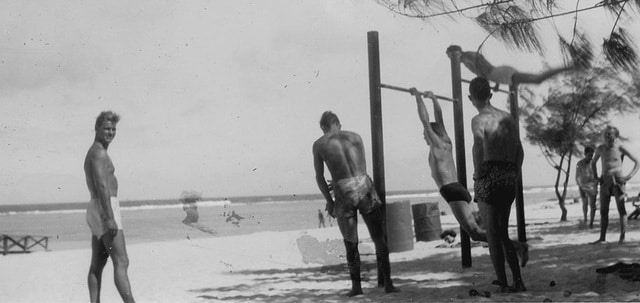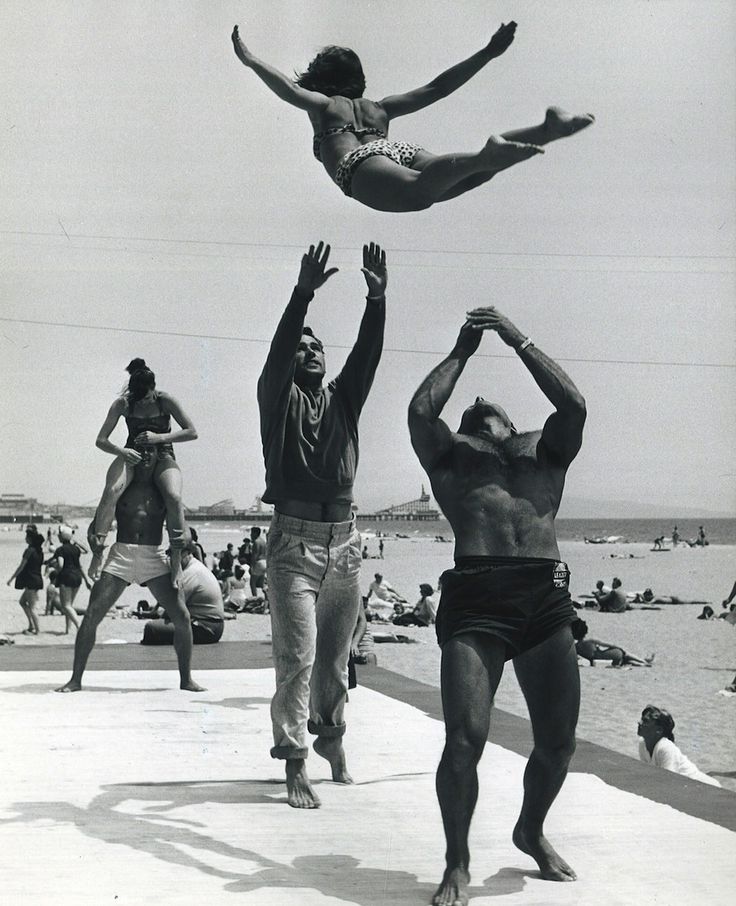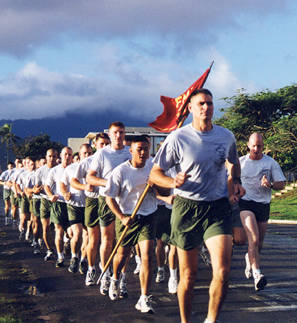Going on vacation (or traveling for business) can throw a lot of things in your life out of their routine — including your diet and strength training program.
Oftentimes the place you’re traveling to doesn’t have the equipment you usually use for your workouts. You’re lucky if a hotel has some dumbbells in their fitness area, and if you’re renting a house, it may lack any equipment at all. Sure, you could find a gym in your area and pay for a day pass, but that’s not an option if you’re away from it all out in nature. And really, you’re on vacation — taking a break from your regular routine is the whole point. You’ve got places to go and things to see. Fitting in an hour-long training session might not be on your agenda.
Then there’s the vacation diet. Sticking to your macros is pretty easy when you’re at home — you can plan your meals out and stock your fridge with plenty of healthy foods. When you’re on vacation, though, you may not have access to a kitchen, so you’ll be eating out a lot, particularly at places that aren’t known for their “light” menus. Plus, again, it’s vacation! It’s a time to indulge and let loose a little.
So given these challenges, how can you balance staying in shape, while also thoroughly enjoying your vacation?
This is a question that has loomed large in my mind as the McKay clan prepares for one of our regular pilgrimages to the Green Mountains of Vermont later this month. We’ll be staying in a house in the middle of nowhere and I won’t have access to the barbells and squat rack I use for my regular workouts. Plus, we’ll definitely be making regular trips to some roadside “snack shacks” for burgers and maple creamees.
So I asked my strength coach Matt Reynolds, owner of Barbell Logic Online Coaching what I should do while I’m away in order to maintain the muscle gainzz I’ve made so far this year, while mitigating the “table muscle” gains I’ll get from stuffing myself with delicious New England fare.
Here’s what he suggested for me and other guys in regards to training and eating on vacation.
Training on Vacation: The Workout
First, some good news for you strength-training practitioners out there: Going a week or two without hoisting some iron will have little detrimental effect on your strength. In fact, research has shown that up to six weeks of inactivity results only in a slight decrease in power. So if you’re worried that skipping a week’s worth of training is going to set you back, don’t. You’ll be fine.
What’s more, taking some time off from strength training might actually set you up for bigger gains down the road. Strength training is taxing on your body. Fatigue can build up to the point that you are overtrained and can no longer fully recover from workouts. The result is stalled progress in your strength gains.
So taking a break from the iron for a few days may be just the thing your body needs to make a full recovery, and prepare itself for pushing past a plateau once you get back home.
With that said, you do want to maintain a little activity while on vacation, primarily to keep your metabolism up as a hedge against packing on the pounds from all the delicious food you’ll be eating.
With that goal in mind, Matt recommends doing short, but intense metabolic conditioning (called “metcon”) workouts while on the road.
For our workout, we’ll be doing intense, full-body circuit routines. Do them every other day. You can do these inside or outside.
Remember, these are metcon workouts — our goal is to make the workout hard and fast. You shouldn’t spend more than 30 minutes with it. You’re on vacation. You’ve got better things to do.
Vacation Bodyweight Workout Routine
Beginner
This routine requires no equipment. Just straight-up old school bodyweight calisthenics. Don’t be fooled though — it’ll scorch you if you go hard.
Do the following exercises, one right after another without stopping. When you complete a circuit, take a break for one or two minutes. If you’re a rank beginner, start with one circuit, and then try to work your way up to six.
- Air Squats 1×10
- Push-ups 1×10
- Lunges 1×10
- Chair Dips 1×10
- Sit-ups 1×10
If you’ve got a pull-up bar or tree limb available, you can substitute chair dips with pull-ups.
Remember, go hard and go fast on this.
Intermediate
If you’re able to complete the above circuit six times, doing sets of 10 for each exercise fairly easily, ratchet up the intensity by doing the same exercises but in a 30 seconds on, 30 seconds off format. You get to rest between sets, but you’re doing a lot more of each exercise, so you’ll be feeling the burn.
It looks like this:
- Air Squats 30 seconds
- Rest 30 seconds
- Push-ups 30 seconds
- Rest 30 seconds
- Lunges 30 seconds
- Rest 30 seconds
- Chair Dips/Pull-ups 30 seconds
- Rest 30 seconds
- Sit-ups 30 seconds
Start off doing just one circuit of 30 seconds on/30 seconds off. As your conditioning improves, add a circuit to your workout. Aim to get up to 6 circuits of 30 seconds on/30 seconds off.
Vacation Kettlebell Routine
If Matt’s driving to a vacation destination that doesn’t have barbells to train with, he’ll usually bring along his 50-pound kettlebell so that he can do a similar metabolic conditioning routine as the bodyweight routine, except with some added resistance. Kettlebells don’t take up much room in the car, making them the ideal fitness equipment to bring along while traveling.
If you’re flying and would like to take a kettlebell with you on the plane (without paying the luggage weight fees), consider getting a portable kettlebell that you can fill with sand or water to the desired weight once you get to your destination.
If you’re staying at a hotel with dumbells, you can substitute a dumbbell for a kettlebell for this routine.
Beginner
Do the following exercises, one right after another without stopping. When you complete a circuit, take a break for one or two minutes. If you’re a rank beginner, start with one circuit, and eventually work your way up to six circuits.
- Kettlebell Swing 1×10
- Push-up (no kettlebell required on this one) 1×10
- Shoulder Press 1×10 (each arm)
- Goblet Squat 1×10
- Snatch 1×10 (each arm)
Intermediate
Do the same exercises, but in a 30 seconds on, 30 seconds off format.
- Kettlebell Swing 30 seconds
- Rest 30 seconds
- Push-up 30 seconds
- Rest 30 seconds
- Shoulder Press 30 seconds each arm
- Rest 30 seconds
- Goblet Squat 30 seconds
- Rest 30 seconds
- Snatch 30 seconds (each arm)
Other Workouts
There are other workout routines you can do while on vacation. Use your imagination. If you’re at the beach, do sand sprint intervals. If you’re going to be in the mountains, do the Woodsman Workout. (I’ll be doing some of those exercises while in Vermont). Or bring along some eminently packable resistance bands and do a resistance band workout. As long as you keep the workouts intense and short, you should be good.
Also, just stay generally active. Swim, bike, walk, and hike — doing so will not only be good for your body, but is the best way to get to know the local area and see its sights, sounds, and smells up close.
Eating While on Vacation
When you’re on vacation, you often face a dilemma when it comes to food. You want to enjoy yourself and not have to worry about macros, but you also don’t want to return home 10 pounds heavier.
Matt recommends a compromise that will allow you to eat what you like without adding too many inches to your waist.
Popularized by John Kiefer, it’s an approach called “carb back-loading.” Research suggests that when we consume carbs early in the day, our fat cells are more sensitive to the insulin spike that occurs after you consume those carbs which causes an increase in fat. If you consume carbs later in the day (and especially right after an intense anaerobic workout), the muscle cells (and not fat cells) are more sensitive to insulin causing muscle growth but not fat growth.
So during the day, you eat as few carbs as possible, sticking with meals that are largely made of protein and fat. When I travel, I usually bring along my protein powder of choice, a bottle of coconut oil, and a shaker to make some fatty protein shakes. I’ll also bring lots of sugar-free, no-carb beef jerky (this is a good one). If I’ll be staying someplace for a long time and have access to a kitchen, I’ll stock the fridge with some bacon, eggs, pre-cooked microwavable chicken breasts, and cold cuts.
Doing your workout right before dinner is ideal, but if your schedule doesn’t allow it, that’s okay.
Then at dinnertime, you enjoy yourself. Eat that burger and fries, and indulge in that maple creamee.
I like to combine carb back-loading with intermittent fasting (not eating for 14-16 hour blocks of time, followed by a “feeding” window), because it seems to up its efficacy, and just makes life easier. So I’ll start off the day by skipping breakfast, and not eating until lunch, which is a protein/fat meal. Then I keep any snacks low-carb until dinner, and don’t eat anything after dinner, fasting until lunch the next day.
Sticking with carb back-loading, with or without intermittent fasting, should allow you to gorge yourself on delicious vacation foods at dinner while minimizing the expansion of your waist.
If your vacation plans includes some carb-tastic breakfasts or lunches, just eat it. Again, you’re on vacation, and you can let up a little. It’s not going to kill you or set you back that much to enjoy a giant stack of pancakes with real Vermont maple syrup.
Bottom line with diet: Do your best, but don’t sweat it too much.
Once you get back home, just get right back into the gym and your regular routine again!









